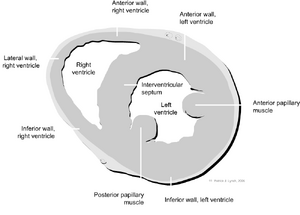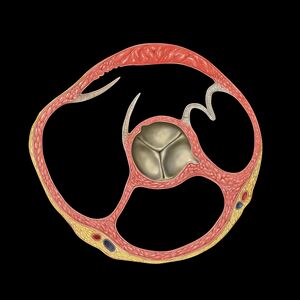Parasternal short axis
Content is incomplete and may be incorrect. |
| Author | I.A.C. van der Bilt | |
| Moderator | I.A.C. van der Bilt | |
| Supervisor | ||
| some notes about authorship | ||
Purposes of Getting a Good Parasternal Short Axis View
The parasternal short axis view is the cross-sectional view of the heart. It analyzes the different sections of the heart from the base to the apex. This view is useful in helping with the diagnosis of mitral stenosis and congenital heart disease, among others.
How to Get a Good Parasternal Short Axis View
As with the parasternal long axis, the probe placement in locating the parasternal short axis is still the same, but the rotation and orientation of the beam differ.
This view is usually taken right after the parasternal long axis view. So with the probe already at the left side of the sternum, to get a good parasternal short axis view, start with rotating the transducer 90° clockwise. The probe has tendency to slide so apply light pressure while manipulating it. For a better view, the patient may be placed in a left lateral decubitus position or the probe may be moved to higher intercostal spaces.
Levels of Imaging in PSS
Theoretically, there are numerous short axes between the apex and base of the heart. However, the parasternal short axis view (SAX) is usually made on three levels: mitral valve level, midpapillary level, and aortic level.
Mitral Valve Level
The tip of the anterior mitral valve leaflet is the most useful starting point in starting this level of inspection of the parasternal short axis view. This level shows the cross section of the left ventricle defined by the thick muscular walls of the interventricular septum and the lateral free wall. Proper recording in this level allows assessment of the wall motion of the mid-left ventricle and mitral leaflet excursion as well as visualization of a part of the right ventricle. Any abnormalities in the curvature of the interventricular septum, and its motion, shape, or position may be detected. A common feature of this level is the so-called “goldfish mouth” look of the mitral valve leaflets. Subtly weeping the beam of the probe from the base to the apex will provide the opportunity to assess the mitral valve orifices, mitral valve chordae and their insertion in the papillary muscles, and coaptation of the leaflets. The use of color Doppler while in the mitral level is useful in the diagnosis of mitral valve regurgitation and its origin and, with M-mode, its timing as well.
| <flash>file=Test13.swf |
| Echocardiographic parasternal short axis. Note the typical shape of the mitral valve |
Midpapillary Level
Tilting the probe toward the apex scans the midpapillary plane of the parasternal short axis. This level in the parasternal short axis view shows the left ventricle clearly between the two papillary muscle groups. The left ventricle is bordered by lateral free wall on its right, the muscular interventricular septum on its left, and the inferior free wall at the bottom. The right ventricle is easily visualized and differentiated from the left because it has only one prominent papillary muscle. This view is ideally used for ventricular wall motion segmental analysis. Thickening and wall motion is visualized in ten segments of the mitral valve and papillary muscle levels.
| <flash>file=SAXPAP_normal.swf |
| A parasternal short axis on midpapillary level |
Aortic Level
The base of the heart or the aortic level of the parasternal long axis view can be visualized by tilting the transducer toward the patient’s right shoulder and by rotating it clockwise. The aortic valve is between the left atrium (anterior) and the right ventricle (posterior). The aortic valve and its three leaflets are part of the so-called Y-shape configuration composed of the coronary in the upper region, right coronary in the lower left, and non-coronary in the left. The following conditions can be assessed using the aortic level of the parasternal short axis view: aortic root size, structural alterations of the Valsalva sinus, proximal aortic dissection, and presence of anomalies of the aortic valve and abnormalities of the valve leaflets. Aside from the aortic valve, the other structures that may be observed from this level are the tricuspid valve (at the left of the aortic valve and above the posteroseptal leaflet), right ventricular outflow tract (along the aortic root), pulmonary valve (at the right and anterior to the aortic valve), and the pulmonary artery and both its left and right branches (around the aorta). This view is often omitted and is hard to acquire.
| <flash>file=SAXAP_normal.swf |
| A parasternal short axis on apical level |

